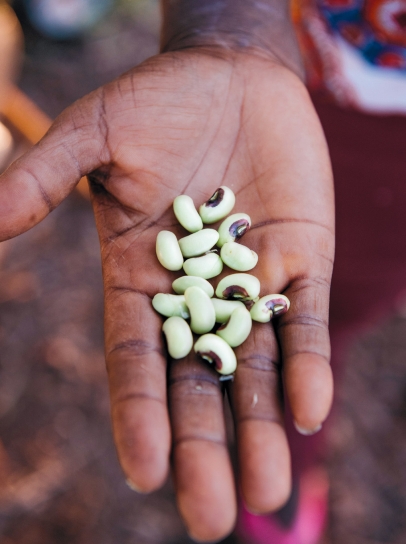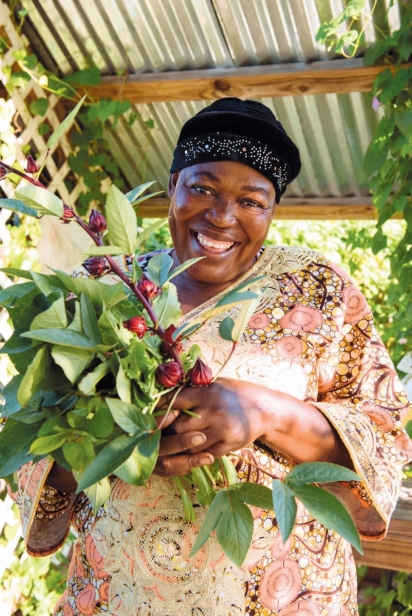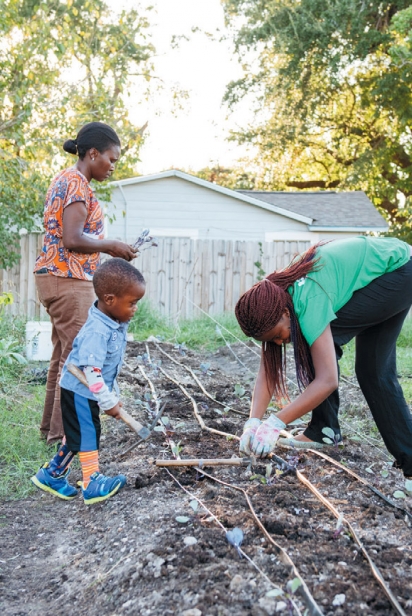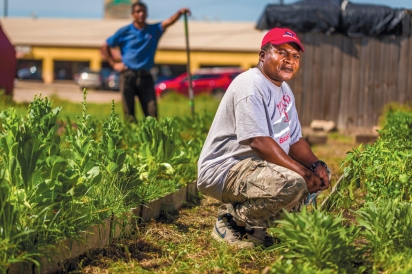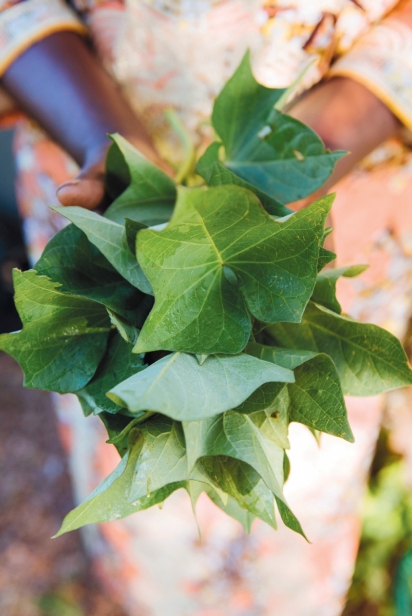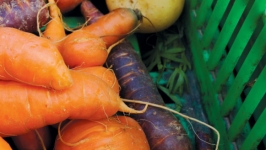Plant It Forward Farmers Growing Global Ingredients to Enrich Our Plates
Plant It Forward farmers enrich Houston’s food scene
Standing on the concrete floor in Plant It Forward’s warehouse, Christine Kengue, a farmer and refugee from the Republic of Congo, picks up a sky blue chef’s knife with her muscular right hand. In her left hand she holds a roselle calyx that resembles an acorn encased in scarlet flower petals.
She places her right thumb on top of the blade and her right middle and ring fingers just under the blade. With her right index finger she presses the tip of the calyx against the blue knife. Holding the bottom of the calyx with her left hand, she expertly rotates it, slicing off the top, then quickly removes the interior capsule. The intact sepals that remain now resemble a flower-petal cup Disney might design for the fairies of Neverland.
As she shares her knowledge, Christine laughs heartily at my astonishment. Thanks to Plant It Forward, the nonprofit that has been helping African refugees farm commercially in Houston since 2011, roselle has become one of my favorite ingredients—but I’ve always peeled the calyx slowly, petal by petal.
People and the foods they farm, cook and eat have been moving around the world for centuries. Sometimes they move by choice, sometimes by force (as was the case with enslaved Africans), sometimes out of desperation and a desire to find a better life. In most cases, they have adapted new ingredients to traditional foodways while maintaining those traditions and influencing the cuisines in their adopted countries.
Roselle
One such global food is roselle, a member of the hibiscus family and a relative of okra, which may be better known in Houston as the main ingredient in the red, tart jamaica agua fresca found in many Mexican restaurants—a drink that has been popular in Mexico since at least 1899.
Roselle likely originated in India or Malaysia before spreading to West Africa. From there, enslaved Africans brought the seeds to the Americas.
The plant has since been given many names and been used for many purposes. In India, the stem fibers have been used to make ropes and burlap bags. In addition to beverages, the calyx is used to make jams in Nigeria, Burma, Australia and Trinidad.
Christine’s daughter, Clech, who is translating as she helps her mother prepare CSA shares, says she sautés the calyxes and serves them as a side dish, often with fried fish. She also told me that the leaves are “the main green we ate in our part of Africa.”
Guy Mouelet, a chef and Plant It Forward alumnus, also enjoys roselle. Guy was forced to flee the Republic of Congo during a bloody civil war, which was partly a Western proxy war over energy resources. He spent several years in Gabon, where he worked his way up from server to executive chef at the Intercontinental Hotel. There, he received formal culinary training and cultivated a small garden that supplied the hotel’s kitchen.
Once in Houston, he became one of Plant It Forward’s first farmers, tending his plot in the mornings while spending his afternoons and evenings working at various restaurants. He now has his eyes set on opening his own restaurant that will focus on garden-to-table international food and finishing his memoir/cookbook, which he is writing in French.
Though Guy no longer farms with Plant It Forward, he still maintains a garden and uses the produce at the Briar Club, where he currently cooks and occasionally makes Congolese-inspired staff meals.
He tells me enthusiastically, “When I am cooking for employees, it’s from me. You can check in all the cookbooks and you won’t find what I’m making. It’s an African dish, but from me. It’s smoked chicken with roselle. In this dish, I mixed a lot of vegetables, to make it a healthy dish. I put my chicken in a smoker. I cook my chopped roselle greens. I mix them with eggplant and okra. When, my chicken is ready, I cut it into small pieces. I add oil to a pan. I chop my onion. Add some garlic. Some diced tomato. I put them in the pan. Sauté for five minutes. I mix in the vegetables, add the chicken and chicken stock, salt and pepper. Taste it. After 15 or 20 minutes it’s ready.”
Amaranth
Christine grew roselle on her farm in the Republic of Congo before she was forced to immigrate to Houston in December 2009. Clech tells me that her mother’s farm in Congo was larger than the one here and that she grew “everything,” including amaranth, which is Christine’s favorite leafy green.
Though a handful of amaranth varieties are native to Africa, Asia and Europe, the majority of the species originated in the Americas, where the grains and leaves have been harvested for thousands of years. Amaranth is also one of the greens used in the traditional Caribbean dish callaloo, especially in Jamaica. In Congolese cuisine, the leaf, which scientist think came from a Latin American variety, is also an important crop.
Christine and Clech prepare the amaranth leaves by first boiling them. The water is drained and the greens rinsed. They then heat palm oil, often called red oil, and “add chopped onion, maybe some garlic. When sizzling, just add the leaves and sauté it. That’s it,” as Clech puts it.
Okra
When I ask Christine if she has any favorite American dishes, Clech interjects, “Let me answer, because I do the cooking. We rarely eat out. We mostly eat at home, mostly the same traditional dishes we had in Africa: Okra and fish. Soup. Some rice and chicken.”
Christine adds, “Cassava.”
Clech continues, “We don’t fry okra. We make soup. We already have fish in the pot. Some onions. Some seasonings. Some tomatoes. Then, we just chop up the okra and add it to the pot.”
This dish strikingly resembles early gumbo recipes. The word “gumbo” likely derives from a Bantu word for okra—a vegetable that was brought to the Americas by enslaved Africans and a language whose dialects are spoken in the Republic of Congo, where Christine grew okra before she grew it here.
Though gumbo, which is a confluence of African, Indigenous and French cuisines, has been served in Louisiana since at least 1803, some of the first printed recipes didn’t appear until La Cuisine Creole was published in 1885. That cookbook includes several gumbo recipes, but the basis for each soup, which is how the author categorizes the dish, is meat or seafood, filé (dried North America sassafras leaves) and sliced okra. (The earliest gumbo recipes don’t include roux, which was a later addition.)
Elizabeth Nyuma and her daughters Oretha and Mabel take a different approach to cooking okra. The Nyumas are from Liberia, which was founded in 1822 as the controversial American Colonization Society’s colony for resettling freed African Americans. After a civil war broke out in Liberia in 1999, Elizabeth’s parents were killed, forcing her and her daughters to flee to neighboring Sierra Leone, which Oretha, who was speaking on behalf of her mother, stressed “was a totally different country for us.”
They lived there for eight years, before qualifying for a United States program that assisted with their resettlement to Houston, where they have lived, according to Oretha, for 10 years. Elizabeth graduated from Plant It Forward’s training program in June 2018 and has been farming full time in Houston for a little over a year, though she started farming in Liberia as a teenager.
Oretha told me, “We slice the okra into small pieces. We usually mix it with eggplant and tomatoes, so it won’t be too slippery. We usually fry [sauté] that. Because, if you boil it, it’s usually watery and slimy. So we fry it in oil and that keeps the slime out.”
Bush Okra and Sweet Potato Greens
As Guy talks about his vision for his restaurant, he tells me, “I love gardening. I love cooking … I like to cook everything: goat, lamb, beef, chicken or fish.” He often cooks his fish with traditional African greens: smoked fish with amaranth, shrimp with roselle and grilled snapper with sautéed sweet potato greens and bush okra leaves.
Sweet potato greens, which are the young leaves from sweet potato vines, a plant that was likely domesticated 5,000 years ago in Latin America, has become an important ingredient in West African cuisines.
They are one of Elizabeth’s favorite greens. Oretha says, “When we cook it, we slice it into tiny pieces. I like to cook it with tomatoes, bell peppers and jalapeños. I blend it with onions. Sauté all of that first … then fold in the sweet potato leaves.”
Guy explains that bush okra is a species that is grown just for the leaves and is different from pod okra. At the warehouse, Christine and Clech, who were bagging bush okra for CSAs, pause to demonstrate how to prep the greens. They pull the small leaves from the stem and roughly chop them.
“We already have the soup in the pot with the meat and just drop in the chopped leaves,” Clech says.
Cassava
On Sundays, Clech says she often cooks a traditional Congolese dish using cassava greens, which Guy, who tells me the greens are called “saka saka” in the Congo, also cooks and serves them with rice. The genetic and anthropological records suggest that cassava originated in Brazil, where it was domesticated thousands of years ago. In the 16th century, Portuguese colonizers introduced the crop to West Africa. Since then, the tubers and leaves have become staples around the world.
In many West African cuisines, cassava tubers are used to make the starchy staple fufu, which both Clech and Oretha occasionally prepare and which Guy cooked for Anthony Bourdain in 2016.
“I told the people who came to eat food with Bourdain to wash your hands,” Guy recalls. “You eat fufu with your hands. No spoon. No fork. That is traditional.”
But on Sundays, Clech cooks the leafy greens. “You have to boil them for a long time, about an hour or so—until the color begins to change. Once they are boiled, you can add fish—something like filleted tilapia. I add cabbage to the fish and cassava leaves. Then, I season it. After I season it, I add red oil—palm oil—to another pan. When the oil gets hot, I add onions. When the onions get hot, I add the oil and onions to the cassava leaves, stir it and leave it for about 15 minutes. Sometimes, I will also add beans. That’s it.”
Pizzas
On Sundays, Guy and his family, immigrants from the Congo, often cook pizza, a food introduced to the United States by Italian immigrants— cultures and cuisines rubbing shoulders as people and food have migrated back and forth across the Atlantic for centuries, sometimes by choice, sometimes by force, sometime under unfortunate circumstances. Some have found themselves in Houston— many, especially Plant It Forward’s farmers, because of the US Refugee Resettlement Program, which has its roots in helping people displaced by World War II and is now threatened by the current administration.
Despite this, Guy—now a citizen and a grandfather—remains positive, planning his future restaurant. His eldest son, who started cooking with Guy in Gabon, is now a cook at the Four Seasons, where his father once worked. His only daughter, who once helped Guy cook for a wedding party of 200, is studying to become a nurse. His fourth child (he has five) will join the Army after he graduates from high school.
As I’m about to wrap up our interview, Guy pauses, then adds, “Thank you to the United States government for initiating this program, for bringing refugees here. I love this country. This is now my country. I love the people. And I love my city, Houston. I try to give. Try to work with all people, so all American people can eat good food.”


